
Night Gallery is an American anthology television series that aired on NBC from December 16, 1970, to May 27, 1973, featuring stories of horror and the macabre. Rod Serling, who had gained fame from an earlier series, The Twilight Zone, served both as the on-air host of Night Gallery and as a major contributor of scripts, although he did not have the same control of content and tone as he had on The Twilight Zone. Serling viewed Night Gallery as a logical extension of The Twilight Zone, but while both series shared an interest in thought-provoking dark fantasy, more of Zone's offerings were science fiction while Night Gallery focused on horrors of the supernatural.
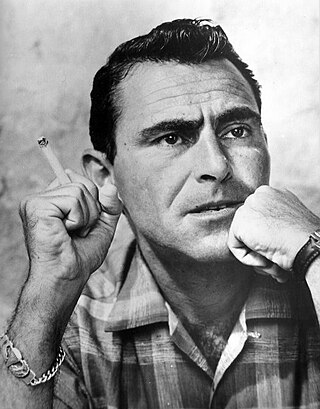
Rodman Edward Serling was an American screenwriter, playwright, television producer, and narrator/on-screen host, best known for his live television dramas of the 1950s and his anthology television series The Twilight Zone. Serling was active in politics, both on and off the screen, and helped form television industry standards. He was known as the "angry young man" of Hollywood, clashing with television executives and sponsors over a wide range of issues, including censorship, racism, and war.
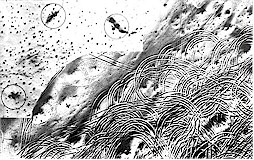
The Battle of Longewala was one of the first major engagements in the western sector during the Indo-Pakistani War of 1971, fought between assaulting Pakistani forces and Indian defenders at the Indian border post of Longewala, in the Thar Desert of Rajasthan state in India. The battle was fought between 120 Indian soldiers accompanied by four Hunter fighter aircraft and 2,000–3,000 Pakistani soldiers accompanied by 30–40 tanks.

The Battle of the Imjin River, also known as the Battle of Solma-ri or Battle of Gloster Hill in South Korea, or as Battle of Xuemali in China, took place 22–25 April 1951 during the Korean War. Troops from the Chinese People's Volunteer Army (PVA) attacked United Nations Command (UN) positions on the lower Imjin River in an attempt to achieve a breakthrough and recapture the South Korean capital Seoul. The attack was part of the Chinese Spring Offensive, the aim of which was to regain the initiative on the battlefield after a series of successful UN counter-offensives in January–March 1951 had allowed UN forces to establish themselves beyond the 38th Parallel at the Kansas Line.
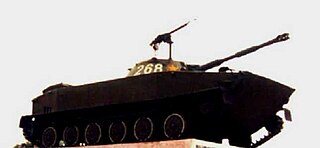
The Battle of Lang Vei began on the evening of 6 February 1968 and concluded during the early hours of 7 February, in Quảng Trị Province, South Vietnam. Towards the end of 1967, the 198th Tank Battalion of the People's Army of Vietnam's (PAVN) 202nd Armored Regiment received instructions from the North Vietnamese Ministry of Defense to reinforce the 304th Division as part of the Route 9–Khe Sanh Campaign. After an arduous journey down the Ho Chi Minh trail in January 1968, the 198th Tank Battalion linked up with the 304th Division for an offensive along Highway 9, which stretched from the Laotian border through to Quảng Trị Province. On 23 January, the 24th Regiment attacked the small Laotian outpost at Bane Houei Sane, under the control of the Royal Laos Army BV-33 "Elephant" Battalion. In that battle, the 198th Tank Battalion failed to reach the battle on time because its crews struggled to navigate their tanks through the rough local terrain. However, as soon as the PT-76 tanks of the 198th Tank Battalion turned up at Bane Houei Sane, the Laotian soldiers and their families retreated into South Vietnam.

The Battle of Ia Drang was the first major battle between the United States Army and the People's Army of Vietnam (PAVN), as part of the Pleiku Campaign conducted early in the Vietnam War, at the eastern foot of the Chu Pong Massif in the central highlands of Vietnam, in 1965. It is notable for being the first large scale helicopter air assault and also the first use of Boeing B-52 Stratofortress strategic bombers in a tactical support role. Ia Drang set the blueprint for the Vietnam War with the Americans relying on air mobility, artillery fire and close air support, while the PAVN neutralized that firepower by quickly engaging American forces at very close range.

Playhouse 90 was an American television anthology drama series that aired on CBS from 1956 to 1960 for a total of 133 episodes. The show was produced at CBS Television City in Los Angeles, California. Since live anthology drama series of the mid-1950s usually were hour-long shows, the title highlighted the network's intention to present something unusual: a weekly series of hour-and-a-half-long dramas rather than 60-minute plays.

The Battle of Mindanao was fought by the Americans and allied Filipino guerrillas against the Japanese forces on the island of Mindanao in the Philippines as part of Operation VICTOR V. It was part of the campaign to liberate the Philippines during World War II. The battle was waged to complete the recapture of the southernmost portions of the archipelago from the Imperial Japanese Army.
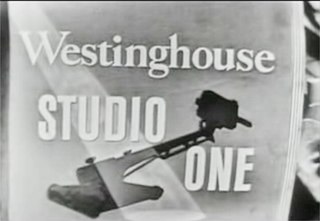
Studio One is an American anthology drama television series that was adapted from a radio series. It was created in 1947 by Canadian director Fletcher Markle, who came to CBS from the CBC. It premiered on November 7, 1948, and ended on September 29, 1958, with a total of 467 episodes over the course of 10 seasons.

The siege of Plei Me was the beginning phase of the first major confrontation between soldiers of the North Vietnamese People's Army of Vietnam (PAVN) and the U.S. Army during the Vietnam War. The lifting of the siege by South Vietnamese forces and American air power was followed by the pursuit of the retreating North Vietnamese from 28 October until 12 November, setting the stage for the Battle of Ia Drang.

The Army of the North, contemporaneously called Army of Peru, was one of the armies deployed by the United Provinces of the Río de la Plata in the Spanish American wars of independence. Its objective was freeing the Argentine Northwest and the Upper Peru from the royalist troops of the Spanish Empire. It was headed by Hipólito Vieytes (1810), Juan José Castelli (1810–1811), Juan Martín de Pueyrredón (1811–1812), Manuel Belgrano (1812–1814), José de San Martín (1814), José Rondeau (1814–1816), Manuel Belgrano (1816–1819) and Francisco Fernández de la Cruz (1819–1820).

The Battle of Taegu was an engagement between United Nations Command (UN) and North Korean forces early in the Korean War, with fighting continuing from August 5–20, 1950 around the city of Taegu, South Korea. It was a part of the Battle of Pusan Perimeter, and was one of several large engagements fought simultaneously. The battle ended in a victory for the UN after their forces were able to drive off an offensive by Korean People's Army (KPA) divisions attempting to cross the Naktong River and assault the city.

The Chaplain–Medic massacre took place in the Korean War on July 16, 1950, on a mountain above the village of Tuman, South Korea. Thirty unarmed, critically wounded United States Army (US) soldiers and an unarmed chaplain were murdered by members of the Korean People's Army (KPA) during the Battle of Taejon.
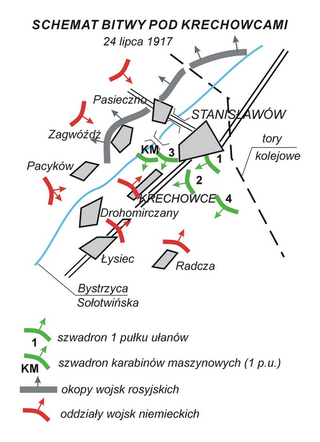
The Battle of Krechowce took place on 24 July 1917, during World War I. Polish uhlans of the Russian Army were ordered to halt Imperial German Army forces advancing on the city of Stanisławów, located in Galicia in Austria-Hungary. The battle between the Polish and German forces took place near the village of Krechowce. The Polish uhlans managed to check the Germans for an entire day, then retreated to Stanisławów.

Operation Silver City was an operation conducted by the 1st Brigade, 1st Infantry Division and the 173rd Airborne Brigade in Biên Hòa Province, lasting from 7 to 23 March 1966.
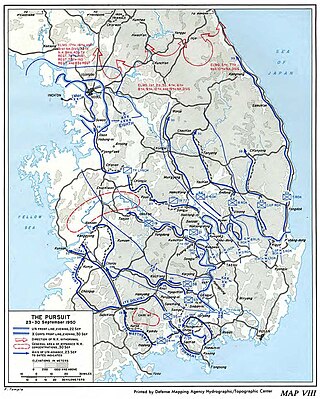
The UN September 1950 counteroffensive was a large-scale offensive by United Nations Command (UN) forces against North Korean forces commencing on 23 September 1950.
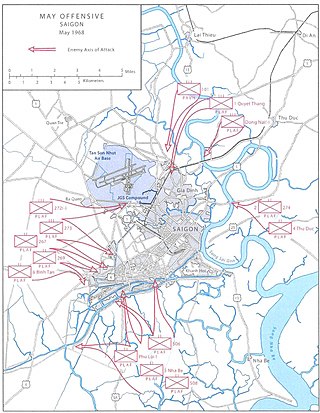
The Battle of West Saigon took place from 5–12 May 1968 during the May Offensive of the Vietnam War as South Vietnamese and United States forces countered the main thrust of the offensive against the western suburbs of Saigon.
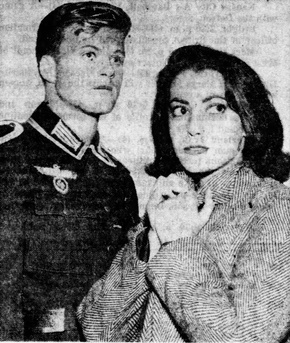
"In the Presence of Mine Enemies" was an American television play broadcast on May 18, 1960. It was the 16th episode of the fourth season of the CBS television series Playhouse 90, and also the final broadcast in the show's four-year run.

"A Town Has Turned to Dust" is the 38th episode of the second season of the American television play broadcast live on June 19, 1958, as part of the second season of the CBS television series Playhouse 90. Rod Serling wrote the teleplay, and John Frankenheimer directed. Rod Steiger and William Shatner starred.


















